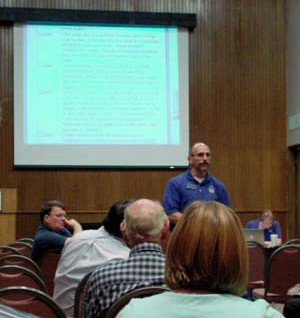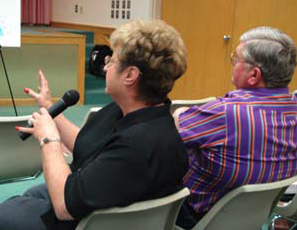Oklahoma’s Water Plan
From the Water Research Institute, Stillwater, Okla.
June 6, 2007
Oklahoma citizens are taking advantage of the opportunity to speak out about Oklahoma’s water resources. Over 530 people have participated in the first 10 of 42 planned Local Input Meetings being conducted across the state.

“We are excited by the number of citizens who have chosen to actively participate in helping to shape the future of Oklahoma’s water resources,” said Mike Langston, Water Research Institute assistant director.
Langston explained that the purpose of the meetings is to listen to citizens express their thoughts on Oklahoma’s water resources. The meetings do include a brief presentation about Oklahoma’s water resources and the current laws regarding ground and surface water. However, the intention of the meetings is for the WRI to listen to the citizens.
“Since there is no plan nor plan agenda yet, there is not much we can tell them, we are there to listen,” said Langston.
Comments from the meetings demonstrate many concerns related to Oklahoma’s current water law and rights as well as water sales and transfers, both in and out-of-state. There have also been comments about water conservation, water quality and education about various water issues.
“It has been great hearing all the comments. Water is becoming more important and it really is time that Oklahoma begin a long-term discussion about how to manage it,” said Langston.
The Oklahoma Water Resources Board agrees. The planning update will require about four years to complete in order to ensure the state has a well-informed and truly comprehensive plan. The OWRB is also conducting technical studies to inventory the state’s water supplies and infrastructure, develop projections of future water use, and investigate Oklahoma’s most important water problems and issues.

“In order to have an effective water plan that fits the needs of Oklahoma and its citizens, the OWRB and legislature must be able to make informed decisions. Citizen input and technical information gathered during the planning process provides us with that opportunity,” said Dave Dillon, OWRB Director of Water Planning.
The recent rains have helped replenish many of the state’s lakes and rivers and may have at least temporarily shifted the focus from not having enough water to flood control. Both issues are important to discuss and the local input meetings are only one way people can comment.
“We have tried to make sure there are multiple ways for people to get involved in the planning process,” said Jeri Fleming, WRI communications manager. “They can come to a meeting, comment on-line, e-mail us or give us a call.”
The WRI’s website, http://okwaterplan.info includes a searchable database of comments and reports from each of the meetings. The website also includes a calendar of meeting dates; currently, about 26 dates are set and the rest will be set in about a month. There is a map of all meeting locations so citizens can see where meetings will be held. Information explaining the citizens input process and a list of frequently asked questions is available.
“We encourage people to search the comments and see what others are saying. It is important to remember not everyone has the same opinion and if someone sees a comment they disagree with, we have provided them the opportunity to say so,” said Fleming.
After the local meetings are completed, there will be a series of regional meetings. The regional meetings provide area citizens the opportunity to consolidate and prioritize the comments in their region.
“It is important that the people who live in an area tell us what the priorities are for their region and the regional meetings provide that opportunity,” said Langston.
For more information, contact WRI at 405-744-9994 or e-mail them at waterplan@okstate.edu. Information packets, comment cards and nomination forms are also available at Oklahoma County Extension Offices.
